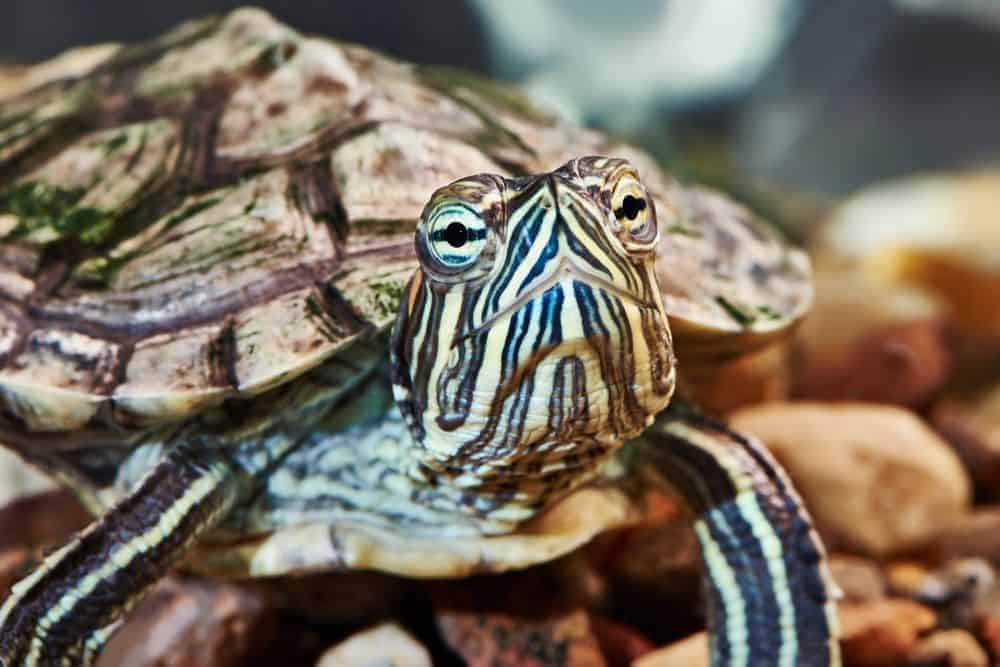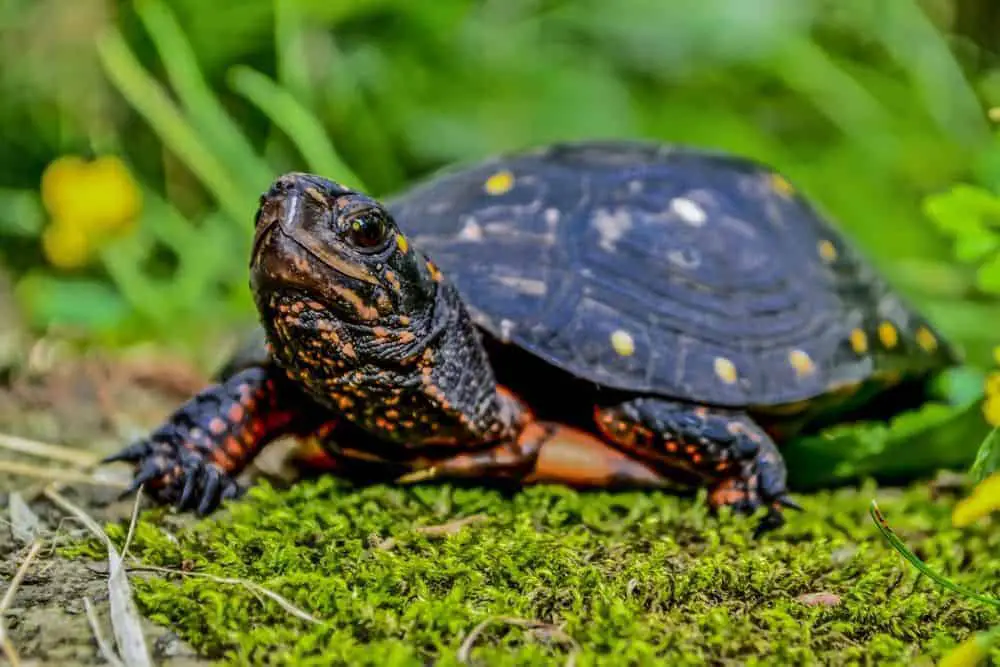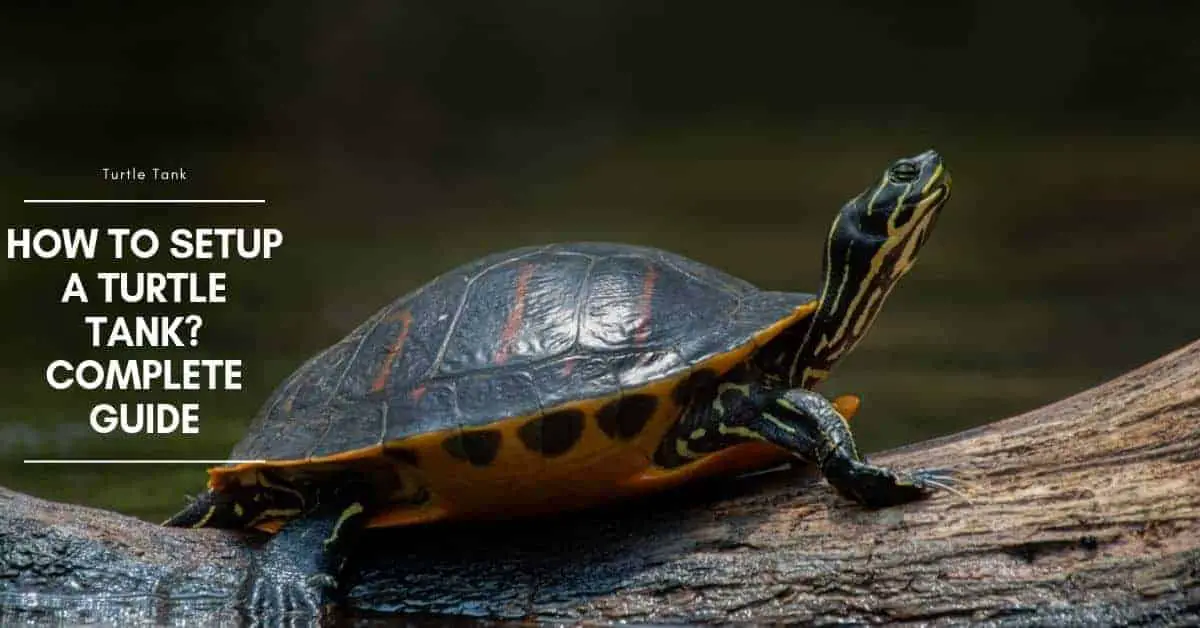If you may want to start with a smaller planted tank, especially if you’re getting a hatchling or juvenile turtle, keep in mind that as the turtle grows you will have to buy bigger setups, including new lighting and filtration systems. It is often less expensive in the long run to buy the proper tank for the adult size of your turtle, to begin with.
For example, you may start with a 30-gallon turtle planted tank for your female Red-Bellied Cooter, but end up needing a 125-gallon tank by the time she reaches adult size. Rather than graduating from 20 gallons to 55, then to 75, then to 125, stockpiling old aquariums as you go along, consider starting with 125 gallons.
One thing to consider is where you will place this planted tank. Some people want to keep the tank in the family room or kitchen where most of the family’s time is spent, in order to give the turtle lots of attention. Unfortunately, this causes unhealthy stress for many turtles. It’s best to place your turtle’s habitat in an area that is calmer.
Once you have the tank, you’ll still have several things to buy. Setup of the tank depends a lot on what kind of turtle you have. Some, like Softshells, spend almost all their time in the water so they don’t need a lot of dry land to walk around on. Others, such as Spotted Turtles, spend less time in the water and more basking and exploring, so they need more dry land in their enclosure. If you get into breeding, the female will need a dry area she can nest in, so the setup you start with may evolve later on. Let’s look at what needs to go in the tank.
Plants for Turtle Tanks
Many turtle species in the wild live in areas with abundant vegetation around the water, and some prefer water with a lot of plant life in it as well. Because turtles tend to disturb plant roots, many keepers choose plastic or silk plants to decorate habitats. Choose as many or as few as you wish.
Real aquatic plants can be used if you prefer. It isn’t easy to keep real plants alive, particularly those that may be uprooted when the turtle is being active. Two plants, java fern, and java weed are easy to use because they are not planted in the substrate.
These turtle aquarium plants can float free, or be tied to a structure, log, or other pieces of habitat furniture. Anacharis is another good plant, but it will be chewed up by plant-loving turtles. Dealing with real plants can add to the headache of general habitat care and cleaning, but the plants do look good in the tank if you’re willing to do the work.
These smooth rocks are usually big enough that turtles won’t try to swallow them. Plus, their size creates interesting climbing opportunities for turtles and places for them to explore. However, make sure your turtle won’t hit the rocks when diving into the water from the basking platform, or it may suffer shell cracks or other injuries.

Setup a turtle tank
Turtle tank light
Do you need UVA and UVB lights?
Lack of good lighting has harmed many turtles in captivity. A full-spectrum bulb is supposed to provide both UVA and UVB rays, like sunlight, but it doesn’t do as thorough a job as turtles need. Real, unfiltered sunlight is always best, but letting the sun shine directly on your tank is a recipe for overheating disasters. Here is a good way to provide enough correct light, the UVB your indoor turtle needs in order to stay healthy, and the right heat for the basking spot:
Use a bulb that offers full-spectrum light, such as ReptiSun 5.0 or the Iguana Light 5.0. Place this bulb in an aquarium hood, or in a fluorescent bulb fixture placed over a screen top. Use a UVB-producing basking lamp, which will also generate heat. PowerSun, Mega-Ray, and UV-Heat are all very popular with experienced turtle keepers.
Tetra AquaSafe Plus, 8.45 Ounces, aquarium Water Conditioner And Dechlorinator, Model Number: 46798162681
15% OffAPI TAP WATER CONDITIONER Aquarium Water Conditioner 16-Ounce Bottle
(as of July 17, 2024 07:37 GMT +03:00 - More infoProduct prices and availability are accurate as of the date/time indicated and are subject to change. Any price and availability information displayed on [relevant Amazon Site(s), as applicable] at the time of purchase will apply to the purchase of this product.)API STRESS COAT Aquarium Water Conditioner 4-Ounce Bottle (85B)
40% OffThese bulbs are a bit more expensive to buy than others, but they will produce UVB at least twice as long as other bulbs, so you won’t need to replace them as often (regular fluorescent UVB bulbs wear out after about six months).
It’s important to give your turtle a “nighttime.” Split the day in half and provide 12 hours of light and 12 hours of darkness. Automatic timers make this much easier.
Thermometers
It’s essential to know what the temperatures are in your turtle’s habitat. Generally, you’ll want three thermometers, and tape thermometers work well. One should give you the temperature for the water, another should read the basking area, and another should be placed away from the basking area, so you can be sure there are cooler areas so your turtle can regulate its body temperature.
Turtle tank filter
This is an absolute necessity unless you want to completely change the water in your tank every couple of days. Because turtles are so much dirtier than fish, you’ll want to have a biological filtration system that will keep the ammonia in the tank under control, as well as a mechanical component that filters waste, leftover food bits and such from the water. A good rule of thumb for filtration is to buy a system that is twice as strong as one recommended for an equal-sized fish aquarium.
For habitat cleaning, you’ll also want a siphon, such as the Python system. This system can help you siphon water out of the tank and add fresh water back in. Also, you’ll want a gravel vacuum. This will clean the bits and pieces out that get stuck in the substrate, at least in substrates smaller than river rock. To help keep the smell of the turtle’s habitat under control, try adding charcoal to your water filter.
When setting up an indoor habitat, many people install a Plexiglass wall to divide their tank. On one side is the water, the other is filled with substrate and becomes the land section. Be sure to place rocks, driftwood, or other furnishings to help your turtle climb out of the water and onto the land portion of the tank.
What should be the water temperature for the turtles planted tank?
Many turtles will do fine in the dark when their enclosure cools to room temperature unless you keep your room below 70 degrees. The water should be around 78-84 degrees Fahrenheit. During the winter, in a cooler room, or for turtles requiring higher heat, you’ll need a ceramic heat emitter at night, when the basking lamp is turned off.
Basking platform
All turtles need a place they can get out of the water on occasion and get completely dry, even underneath. In fact, some species spend a great deal of time sunning themselves out of the water. For that, you need a basking platform of one kind or another.
You can use commercially produced plastic platforms, or create your own. Some keepers choose a thick, flat piece of driftwood or pile up rocks with a flat rock on top. As long as it is secure and not going to fall over or slip when your turtle climbs aboard, and it’s large enough to hold your turtle completely out of the water, that’s what matters.
The rest is just aesthetics and entirely up to you. One very creative way to provide a basking platform for a larger turtle is to build a separate box, complete with basking light, that fits on top of one end of the turtle aquarium, above the waterline.
Turtle tank sand, gravel or other substrates?
This is the material that makes up the land portion of the habitat. While the substrate is often used to cover the floor of the water portion as well, many owners choose to leave the water part of the habitat bare.
It doesn’t look quite as nice as a layer of gravel on the bottom of the tank, but it is easier to clean and there’s no chance that the turtle will try to swallow bits of gravel or rock. This approach won’t work with some species. Softshells enjoy burying themselves in the sand, so they really need an appropriate substrate.
Acceptable substrates vary with the turtle species, as noted in the Species Specifics section, but here are some of the options:
Sand
Many turtles are very fond of sand, but it wreaks havoc on filtration systems because the turtles stir it up so frequently. It is not an easy substrate for a keeper to live with.
Aquarium or Pea Gravel
Available in different sizes, this gravel is commonly used in turtle setups, though if you have a turtle that likes to swallow stones, it’s best to use either a larger substrate the turtle can’t eat or the smallest diameter gravel which won’t clog the turtle’s intestines. Pea gravel is available at home improvement stores in larger quantities and lower prices than aquarium gravel.
River rock
Water and water heaters
Tap water is usually fine for turtles unless you have really bad water or water that is heavily chlorinated. You can use bottled water, of course, though that will prove expensive with a large setup and regular water changes. If you have a commercial filter on your tap already, the water will be fine.
If you’re concerned about the water, you can use one of the animal-safe conditioners designed to neutralize the water, such as ReptiSafe. As far as water pH (acidity/alkalinity), there are some species that have particular requirements, but those turtles are not recommended for the novice owner.
Some turtles like their water in the low 70s, which is about room temperature in many households. Use a thermometer to test the water. If it stays in the correct range, you don’t need a water heater. If it fluctuates too much or stays too cold, you’ll need a heater. A submersible aquarium heater is fine, but a heater guard is a really good idea, both to keep the turtle from harming itself and to protect the heater from an active turtle.

Other furnishings to put in the turtle tank
Turtles often need places to hide and things to investigate in their tanks. Plus, many turtles who like deep water also need things they can stand on underwater when they get tired, so they can stick their nose out of the water to breathe. Driftwood, fake log structures, and large rocks all make excellent habitat furnishings. When setting up the habitat, just make sure there are no large rocks that a turtle might hit when diving from the basking platform.
Tank cover
Turtles are not only great swimmers, but they are also strong climbers. If they are able to reach the top of the tank, they can get out, drop to the floor and either suffer injury from the drop or get into all sorts of trouble once on the ground. A cover over the tank will prevent this from happening. A cover also makes it easier to suspend lighting over the tank.
The best type of cover is a metal screen, especially if you attach it with clips to keep strong turtles from pushing it off. You can place the light bar for your turtles directly over the screen, cutting holes in the screen as necessary for the filtration system and water heater cord. Aquarium hoods with glass over the light won’t work unless you remove the glass, because the glass will filter important UVB light.

Hi, my name is Sean, and I’m the primary writer on the site. I’m blogging mostly about freshwater and saltwater aquariums, fish, invertebrates, and plants. I’m experienced in the fishkeeping hobby for many years. Over the years I have kept many tanks, and have recently begun getting more serious in wanting to become a professional aquarist. All my knowledge comes from experience and reading forums and a lot of informative sites. In pursuit of becoming a professional, I also want to inspire as many people as I can to pick up this hobby and keep the public interest growing.
Read more about Sean.
Please join also my Facebook group.



















